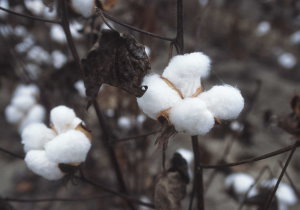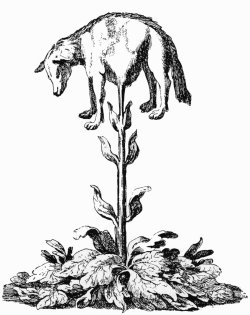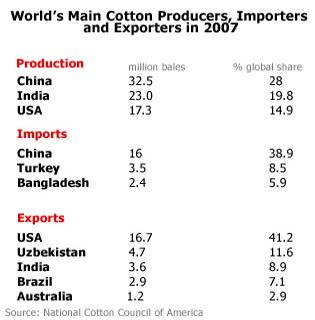
Cotton Bolls
Ready for Harvest
The word cotton (c.1286) is from the Old French coton. It entered French via the Provencal, Italian, or Old Spanish languages. The origin of the word is Arabic qutn.
Cotton is a soft, staple fiber that grows in a form known as a boll around the seeds of the cotton plant, a shrub native to tropical and subtropical regions around the world. The fiber most often is spun into yarn or thread and used to make a soft, breathable textile, which is the most widely used natural - fiber cloth in clothing today.
Cotton has been spun, woven, and dyed since prehistoric times. It clothed the people of ancient India, Egypt, and China. Hundreds of years before the Christian era, cotton textiles were woven in India with matchless skill, and their use spread to the Mediterranean countries. In the 1st Century A.D., Arab traders brought fine muslin and calico to Italy and Spain.

The Vegetable Lamb of Tartary is a semi - legendary plant of central Asia, believed to grow sheep as its fruit. The sheep were connected to the plant by an umbilical and grazed the land around the plant. When all the plants were gone, both the plant and sheep died. Although it owed its currency in medieval thought as a way of explaining the existence of cotton, underlying the myth is a real plant, the Cibotium barometz.

The Moors introduced the cultivation of cotton into Spain in the 9th century. Fustians and dimities were woven there and in the 14th century in Venice and Milan, at first with a linen warp. Little cotton cloth was imported to England before the 15th century, although small amounts were obtained chiefly for candlewicks.
During the late medieval period, cotton became known as an imported fiber in Northern Europe, without any knowledge of how it was derived, other than that it was a plant. Noting its similarities to wool, people in the region could only imagine that cotton must be produced by plant - borne sheep. John Mandeville, writing in 1350, stated as fact the now - preposterous belief:
There grew there [India] a wonderful tree which bore tiny lambs on the endes of its branches. These branches were so pliable that they bent down to allow the lambs to feed when they are hungrie.
This aspect is retained in the name for cotton in many European languages, such as German Baumwolle, which translates as tree wool
(Baum means tree
; Wolle means wool
).
The advent of the Industrial Revolution in Britain during the 18th century, provided a great boost to cotton manufacture, as textiles emerged as Britain's leading export. Philip Miller of the Chelsea Physic Garden sent the first cotton seeds to the American colony of Georgia in 1732. Production capacity was further improved by the invention of the cotton gin by Eli Whitney in 1793.
By the mid 19th century, King Cotton
had become the backbone of the southern American economy.
In the United States, cultivating and harvesting cotton became the leading occupation of slaves.
In addition to the textile industry, cotton is used in fishnets, coffee filters, tents, gunpowder, cotton paper, and in bookbinding. The first Chinese paper was made of cotton fiber. Fire hoses were once made of cotton. The cottonseed which remains after the cotton is ginned is used to produce cottonseed oil, which, after refining, can be consumed by humans like any other vegetable oil. The cottonseed meal that is left generally is fed to livestock.

